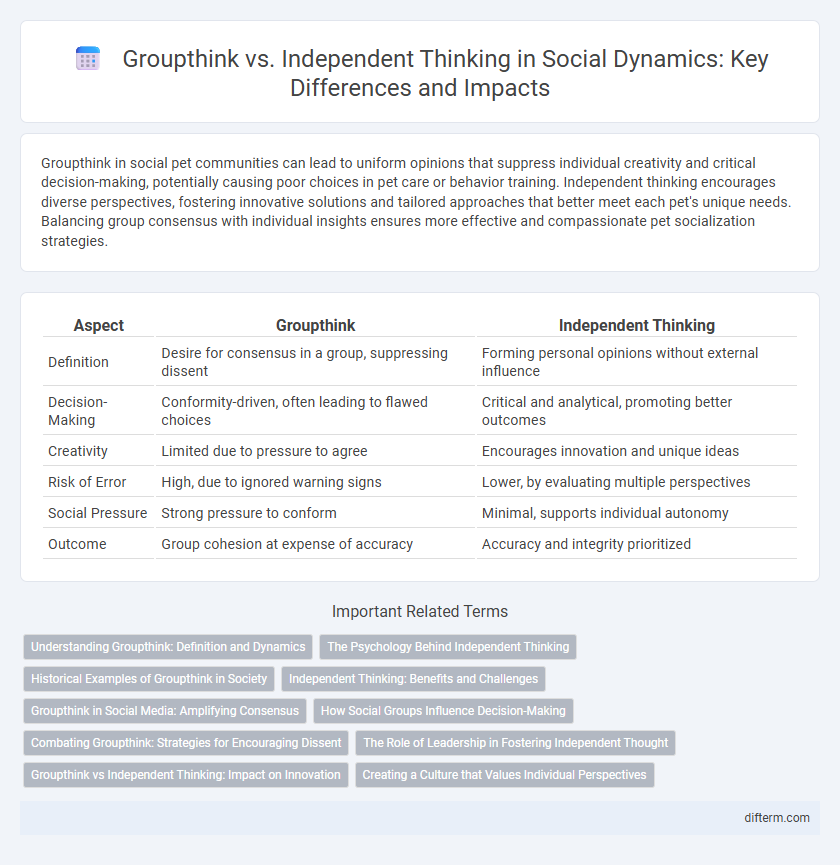Groupthink in social pet communities can lead to uniform opinions that suppress individual creativity and critical decision-making, potentially causing poor choices in pet care or behavior training. Independent thinking encourages diverse perspectives, fostering innovative solutions and tailored approaches that better meet each pet's unique needs. Balancing group consensus with individual insights ensures more effective and compassionate pet socialization strategies.
Table of Comparison
| Aspect | Groupthink | Independent Thinking |
|---|---|---|
| Definition | Desire for consensus in a group, suppressing dissent | Forming personal opinions without external influence |
| Decision-Making | Conformity-driven, often leading to flawed choices | Critical and analytical, promoting better outcomes |
| Creativity | Limited due to pressure to agree | Encourages innovation and unique ideas |
| Risk of Error | High, due to ignored warning signs | Lower, by evaluating multiple perspectives |
| Social Pressure | Strong pressure to conform | Minimal, supports individual autonomy |
| Outcome | Group cohesion at expense of accuracy | Accuracy and integrity prioritized |
Understanding Groupthink: Definition and Dynamics
Groupthink is a psychological phenomenon where the desire for harmony in a decision-making group leads to irrational or dysfunctional outcomes by suppressing dissent and critical thinking. It often results in conformity to group opinions, ignoring alternative ideas or risks, which can undermine effective problem-solving. Independent thinking, in contrast, encourages diverse perspectives and critical evaluation, promoting healthier group dynamics and more innovative solutions.
The Psychology Behind Independent Thinking
Independent thinking stems from cognitive autonomy, enabling individuals to evaluate information critically without succumbing to group influence. The psychology behind independent thinking involves metacognition, self-reflection, and the ability to resist social conformity pressures inherent in groupthink dynamics. Neural mechanisms related to executive function and prefrontal cortex activity play crucial roles in sustaining independent judgments against normative group consensus.
Historical Examples of Groupthink in Society
Groupthink has historically impaired critical decision-making, as seen in the Bay of Pigs invasion where U.S. officials pursued a flawed plan due to conformity pressures. The Challenger Space Shuttle disaster also exemplifies groupthink, with engineers and managers dismissing safety concerns to maintain consensus. These cases underscore the societal risks when independent thinking is suppressed in favor of group cohesion.
Independent Thinking: Benefits and Challenges
Independent thinking fosters creativity, critical analysis, and personal accountability, enhancing decision-making quality and innovation within social groups. It encourages individuals to question norms and resist conformity pressures, promoting diverse perspectives and authentic solutions. However, independent thinkers may face social isolation or resistance, requiring resilience to maintain their viewpoints amid groupthink dynamics.
Groupthink in Social Media: Amplifying Consensus
Groupthink on social media amplifies consensus by promoting uniform opinions within online communities, often suppressing dissenting views through peer pressure and algorithm-driven content curation. This phenomenon leads to echo chambers where information is reinforced without critical evaluation, reducing diversity in thought and hindering innovative problem-solving. Social platforms' emphasis on likes and shares intensifies conformity, impacting public discourse and decision-making processes.
How Social Groups Influence Decision-Making
Social groups significantly influence decision-making by promoting conformity through shared norms and pressures, often leading to groupthink--a phenomenon where the desire for harmony overrides critical evaluation. Independent thinking challenges this by encouraging diverse perspectives and critical analysis, which are essential for more balanced and effective decisions. Understanding the dynamics of social influence helps in recognizing when group cohesion impedes objective judgment, fostering environments that value both collaboration and individual insight.
Combating Groupthink: Strategies for Encouraging Dissent
Encouraging dissent is crucial for combating groupthink and fostering independent thinking within social groups. Implementing strategies like appointing a devil's advocate, promoting anonymous feedback, and ensuring diverse group composition can create an environment where alternative viewpoints thrive. These methods enhance decision-making quality by reducing conformity pressure and stimulating critical analysis.
The Role of Leadership in Fostering Independent Thought
Effective leadership cultivates an environment where independent thinking thrives by encouraging diverse perspectives and questioning of assumptions. Leaders who model critical thinking and openness to dissent reduce the risk of groupthink, enabling innovation and informed decision-making. Empowering team members with psychological safety boosts creativity and accountability, essential for resilient organizational growth.
Groupthink vs Independent Thinking: Impact on Innovation
Groupthink suppresses creativity by prioritizing consensus over individual ideas, limiting the diversity of thought essential for innovation. Independent thinking encourages critical analysis and unique perspectives, driving breakthroughs and novel solutions. Organizations fostering independent thinking experience higher levels of innovation and adaptability in dynamic markets.
Creating a Culture that Values Individual Perspectives
Creating a culture that values individual perspectives requires encouraging open dialogue and rewarding diverse viewpoints within social groups. Emphasizing critical thinking and personal accountability helps counteract groupthink by fostering an environment where independent ideas can flourish. Organizations that prioritize psychological safety see increased innovation and more effective decision-making through the inclusion of varied individual contributions.
groupthink vs independent thinking Infographic

 difterm.com
difterm.com